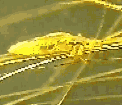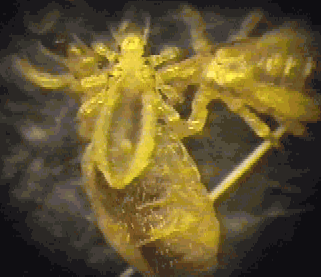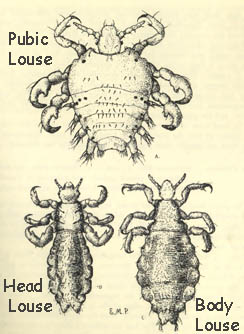| "And
here... same sample", he said, standing out of the way so I could look
for meself.
As I
peered at the lice, he carried on talking - as if to guide my observations.
"Watch how they move, especially the legs. Notice how the legs are jointed
so that they appear to form a 'u' shape with the sides of the 'u' pointing
towards their heads!"
|


 Same sample from Vanessa's head.
Same sample from Vanessa's head.
|


Sample from pubic area and underwear
|
"Now
take a look at these", he said - switching the samples under the microscope
and zooming in closer for me."
These
were taken from Vanessa pubic hair and her underwear. Notice any difference?"
"Sure...
", I told him - "their bodies are fatter, kinda wider!"
"Correct!
But more...", he challenged me. "Look at their legs. Can you see they are
more poised. Look at the rear legs especially. They are jointed to form
an upside-down 'u' with the sides of the 'u' pointing back towards
the rear."
I could
see what he meant. We were dealing with two different types of lice!
I only knew about hair-lice (or as some people say - head lice),
so I reckoned the other ones were 'crabs' or pubic lice... which made me
kinda angry that some no-good creep had taken advantage of my Van while
she was drunk and ill.
"Crabs..!",
I blurted out.
|
 Mol
smiled. "No.. not pubic lice, Larry - something much more sinister. Find
me that book I gave you from John Wells a year ago when you were trying
to sort out the head lice problem. I think we're not just dealing here
with head lice (Pediculus capitis) but an additional and more dangerous
form: Body Lice - or more precisely - Pediculus corporis... a vector
of Typhus and Trench fever. Mol
smiled. "No.. not pubic lice, Larry - something much more sinister. Find
me that book I gave you from John Wells a year ago when you were trying
to sort out the head lice problem. I think we're not just dealing here
with head lice (Pediculus capitis) but an additional and more dangerous
form: Body Lice - or more precisely - Pediculus corporis... a vector
of Typhus and Trench fever.
I got
the book and found the reference to human lice:-

 The lice
we found on Vanessa were the HEAD LOUSE and the BODY LOUSE. These
are not actually different species of human lice. They can cross-breed
with each other.
The lice
we found on Vanessa were the HEAD LOUSE and the BODY LOUSE. These
are not actually different species of human lice. They can cross-breed
with each other.
|
We
read through the definite text. The book was written aeons ago around the
1930's - when researchers had time to get proper results and make detailed
observations without those pressures on such professionals today
to hit deadlines and money targets. This then is a summary of what we found
out:-
Head Louse
The
head louse feeds frequently, discharging large amounts of excreta which
stick to the hairs. Adults live for about 30 days. Mainly spread by contact
with the head of a lousy person. Egg-laying begins about 24-36 hours after
the adult stage is reached and from 3-9 eggs are laid each day. Up to 300
eggs may be laid by one adult during its lifetime.
Body Louse
Egg
laying cycle - same as head louse. Eggs laid on clothes, especially
woolly material. Eggs hatch in 5 - 12 days. Larva form into 1st nymph in
2 - 4 days, and 2nd nymph in 3 - 6 days. Therefore 1 louse egg can develop
into an egg-laying louse in 16 days. Larva feed immediately on emerging
from egg.
Body
lice tend to wander from an infested person's under-garments to their external
clothing. Momentary brushing against an infested person is all that is
required for the wandering louse to transfer to a new host.
Pubic Louse
Found
mainly in the pubic and peri-anal regions. Legs adapted structurally for
clinging to widely separated hairs. May spread to the abdomen. Pubic lice
have also been recorded living in beards and on eyelashes. Larva differ
in their feeding habits from head and body lice: they stay at the same
spot without removing their mouth-parts.
|
|
Lice and Disease
We skipped
over a lot of stuff which you can see by going to 'solutions'
in the index at the foot of this page. Mol and I found and read the text
on lice-borne disease - which is what we were really interested in. It
said:-
Body lice and head lice can be vectors of Typhus,
Trench Fever, and Relapsing Fever. Pubic lice are not thought to be disease
vectors and are not known to transmit any parasite to man.
Typhus
Fever (summary)
Incubation
period 9 - 20 days. Rickettsia prowazeki, a micro-organism living
in lice tissue, is believed to be the casual organism which is thought
to be transferred to humans either through bite or by faeces of the louse.
There is a stronger case for the body louse rather than the head louse
being the main vector of the disease.
Apart
from sporadic cases in ports, Typhus has practically disappeared from the
UK. War, poverty, and dirt favour its spread.
Trench
Fever (summary)
A milder
form of Typhus, first identified during the First World War. Characterised
by much pain in the shins along with the symptoms described for Typhus.
Different studies dispute whether or not the disease is spread by bite
or by faeces of body lice.
Symptoms
of these diseases
Onset
very abrupt with chills, pains in the back and legs, severe headache, nausea,
vomiting, and high temperature. In early stage, patient is prostrated but
cannot sleep. After 4 days, patient becomes delirious, and a rash appears
- starting in the armpits and wrists and spreading to the chest, abdomen,
and then to the limbs. It is mottled and dusky with spots of irregular
size and shape. Hiccup may develop and it is a grave sign! In unfavourable
cases, death may occur during coma. In other cases, the infected person
goes through a crisis in around 14 days and after sleeping awakes very
weak but relieved of the symptoms. In some epidemics, the disease tends
to be mild - in others it is fatal in 2 to 3 days! Treatment: antibiotics.
|





